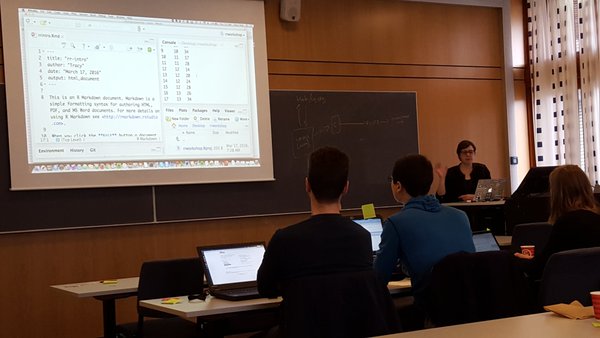As part of my training to become an instructor-trainer for Software and Data Carpentry, I want to help further develop the material used during instructor training workshops. Greg Wilson, who heads the instructor training, and I, decided to make some videos to demonstrate good and not-so-good practices when teaching workshops. Greg recently released his “example of bad teaching” video focussing on general teaching techniques.
For my contribution, I wanted to demonstrate as many aspects as I could of what I wrote in my “10 tips and tricks for instructing and teaching by means of live coding” post.
So here was the plan:
- make two 2-3 minute videos with contrasting ways of doing a live coding session
- one demonstrates as many ways as possible how to not do this
- one uses as many good practices as possible
- during the instructor-training workshop, participants are asked (in small groups) to discuss the differences and their relevance.
With help from colleague Tore Oldeide Elgvin (the cameraman) and local UiO Carpentry organisers Anne Fouilloux and Katie Dean (playing the role of learners), we recorded the videos. It took about two hours and a dozen attempts, but it was fun to do. Amazing how difficult it is to not doing your best while teaching…
Here are the videos – watch them before you read on about what they were supposed to show. Note that (part of) the unix shell ‘for-loop’ lesson is what is being taught. It is assumed the instructor has already explained shell variables (when to use the ‘$’ in front and when not).
Many thanks to Tore, Anne and Katie for helping out making these videos!
Part 1:
Part 2:
Part 1:
- instructor ignores a red sticky clearly visible on a learner’s laptop
- instructor is sitting, mostly looking at the laptop screen
- instructor is typing commands without saying them out loud
- instructor uses fancy bash prompt
- instructor uses small font in not full-screen terminal window with black background
- the terminal window bottom is partially blocked by the learner’s heads for those sitting in the back
- instructor receives a a pop-up notification in the middle of the session
- instructor makes a mistake (a typo) but simply fixes it without pointing it out, and redoes the command
Part 2:
- instructor checks if the learner with the red sticky on her laptop still needs attention
- instructor is standing while instructing, making eye-contact with participants
- instructor is saying the commands out loud while typing them
- instructor moves to the screen to point out details of commands or results
- instructor simply uses ‘$ ‘ as bash prompt
- instructor uses big font in wide-screen terminal window with white background
- the terminal window bottom is above the learner’s heads for those sitting in the back
- instructor makes mistake (a typo) and uses the occasion to illustrate how to interpret error-messages

